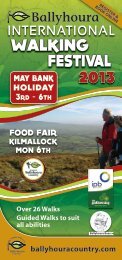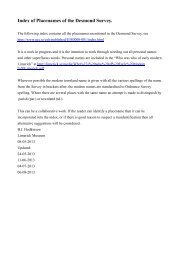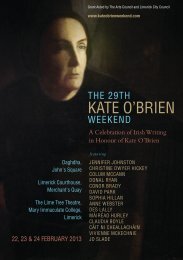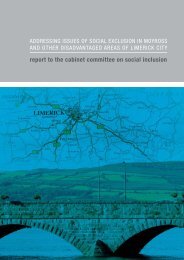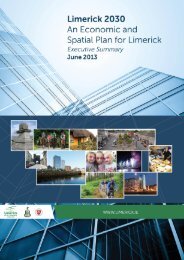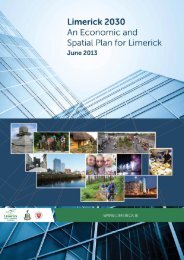An Economic and Spatial Plan for Limerick Appendices
An Economic and Spatial Plan for Limerick Appendices
An Economic and Spatial Plan for Limerick Appendices
You also want an ePaper? Increase the reach of your titles
YUMPU automatically turns print PDFs into web optimized ePapers that Google loves.
<strong>Limerick</strong> 2030 <strong>An</strong> <strong>Economic</strong> <strong>and</strong> <strong>Spatial</strong> <strong>Plan</strong> <strong>for</strong> <strong>Limerick</strong><br />
5. City Centre <strong>Spatial</strong> <strong>An</strong>alysis<br />
The success of any City Centre is determined by a complex interplay of physical, economic <strong>and</strong><br />
social factors. Our analysis draws upon the wider economic analysis set out in the previous section.<br />
The physical appraisal addresses the built environment – buildings, public realm <strong>and</strong> transport<br />
infrastructure. It considers the city fabric from the point of view of what makes an attractive <strong>and</strong><br />
vibrant City Centre – highlighting the strengths <strong>and</strong> weaknesses <strong>and</strong> focussing on the opportunities.<br />
Much of the analysis in the City Centre Public Realm Strategy <strong>and</strong> in the City Centre Strategy (2008)<br />
is sound <strong>and</strong> may be replicated in this document.<br />
Complementing a thematic analysis we examine individual character areas of the City Centre to<br />
enable a more detailed, local underst<strong>and</strong>ing of how different parts of it are functioning.<br />
<strong>Spatial</strong> <strong>An</strong>alysis<br />
Historical Development<br />
<strong>Limerick</strong> exists due to the River Shannon. The City of <strong>Limerick</strong> is located at the head of the Shannon<br />
Estuary at the point where the counties of <strong>Limerick</strong> <strong>and</strong> Clare meet. The City was established<br />
originally as a Viking Settlement in the 9 th Century, at a strategic crossing point on the River <strong>and</strong><br />
developed into an important <strong>and</strong> much fought over military <strong>and</strong> trading centre.<br />
In 1194 the City fell under the control of the Normans <strong>and</strong> a large castle was built by King John<br />
adjacent to the River Shannon on Kings Isl<strong>and</strong>. The City almost doubled in size in the 13 th Century <strong>and</strong><br />
by 1500 the City had developed into two sectors; English Town <strong>and</strong> Irish Town. English Town was<br />
positioned on Kings Isl<strong>and</strong> framed by the River Shannon <strong>and</strong> its tributary, Abbey River, whilst Irish Town<br />
was positioned on the South Bank of the Abbey River directly opposite. The sectors were connected<br />
by a single bridge giving a distinctive shape which lasted until the middle of the 18 th Century.<br />
During the 200 years from 1500 to 1700, <strong>Limerick</strong> experienced the implications of the dissolution of the<br />
monasteries in the 1540’s, the remodelling of King John’s Castle 1611, the destruction <strong>and</strong> rebuilding<br />
of much of <strong>for</strong>tifications during the civil wars of the 1640’s <strong>and</strong> later during the Cromwellian Siege of<br />
1651.<br />
During this period the City grew in prominence <strong>and</strong> new public buildings appeared in English Town<br />
during the 17 th Century. The buildings included the new exchange on Nicholas Street, built in 1674<br />
<strong>and</strong> a new custom house on Merchants Quay built in 1683. This period also saw the expansion of the<br />
markets in both towns crowned by the building of a new market house in Irish Town in 1673.<br />
June 2013 67




